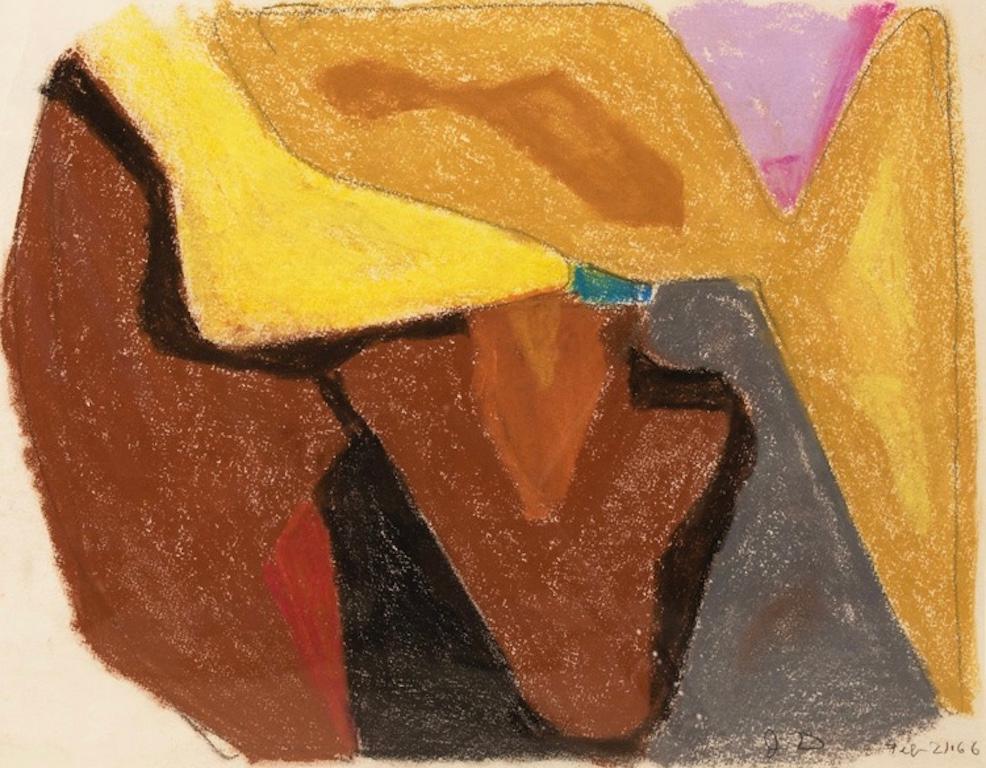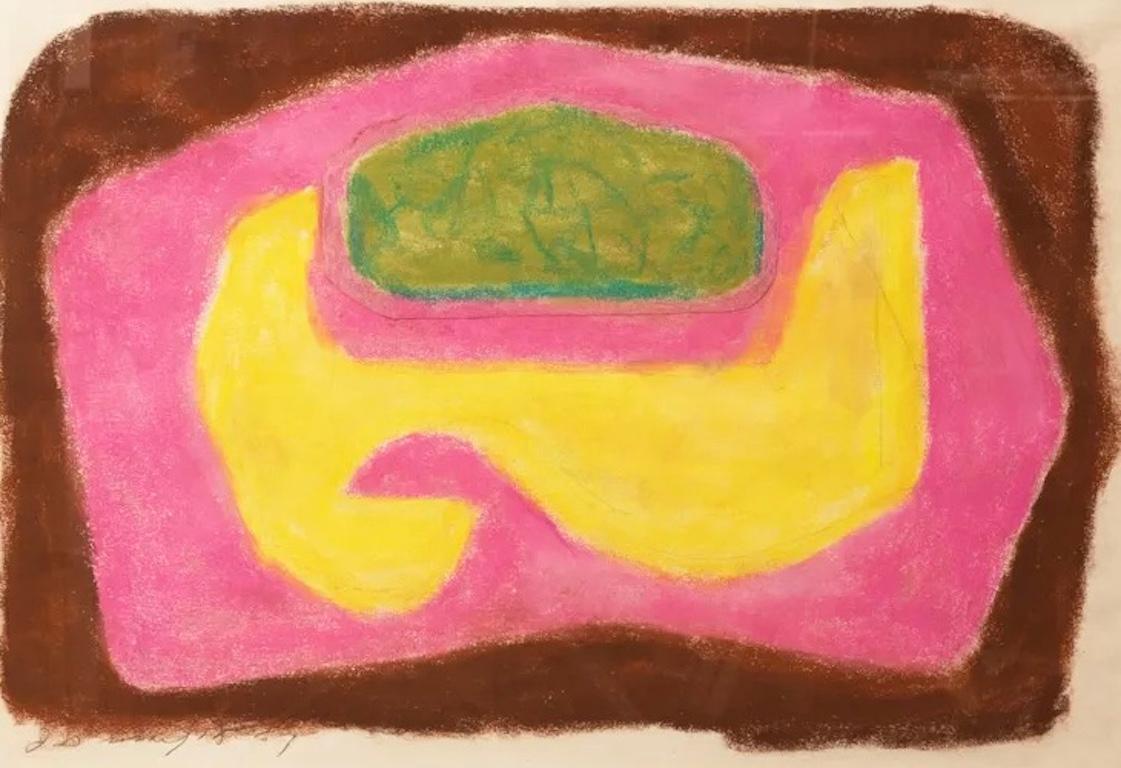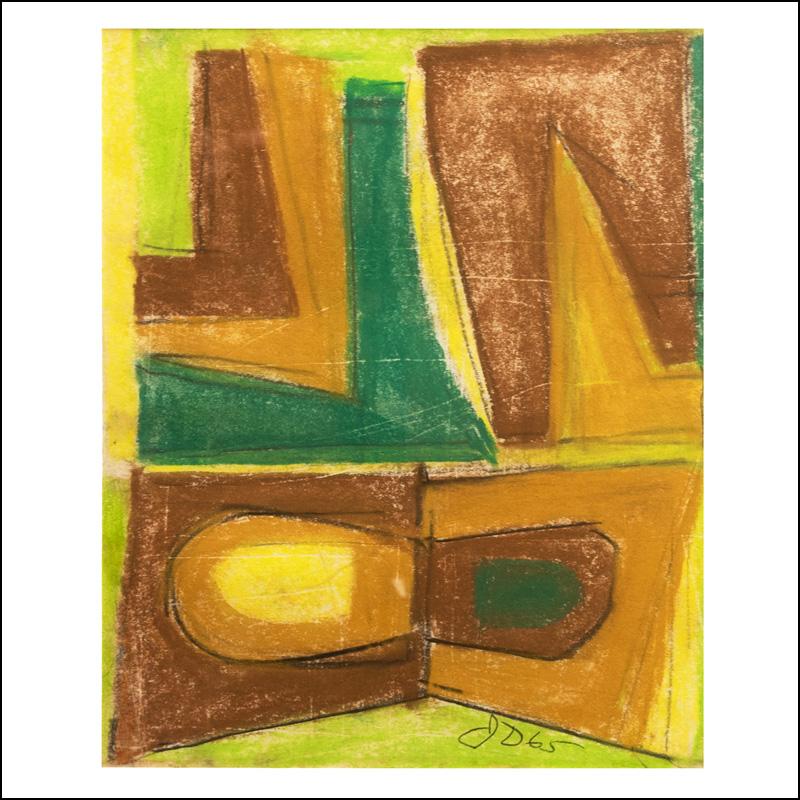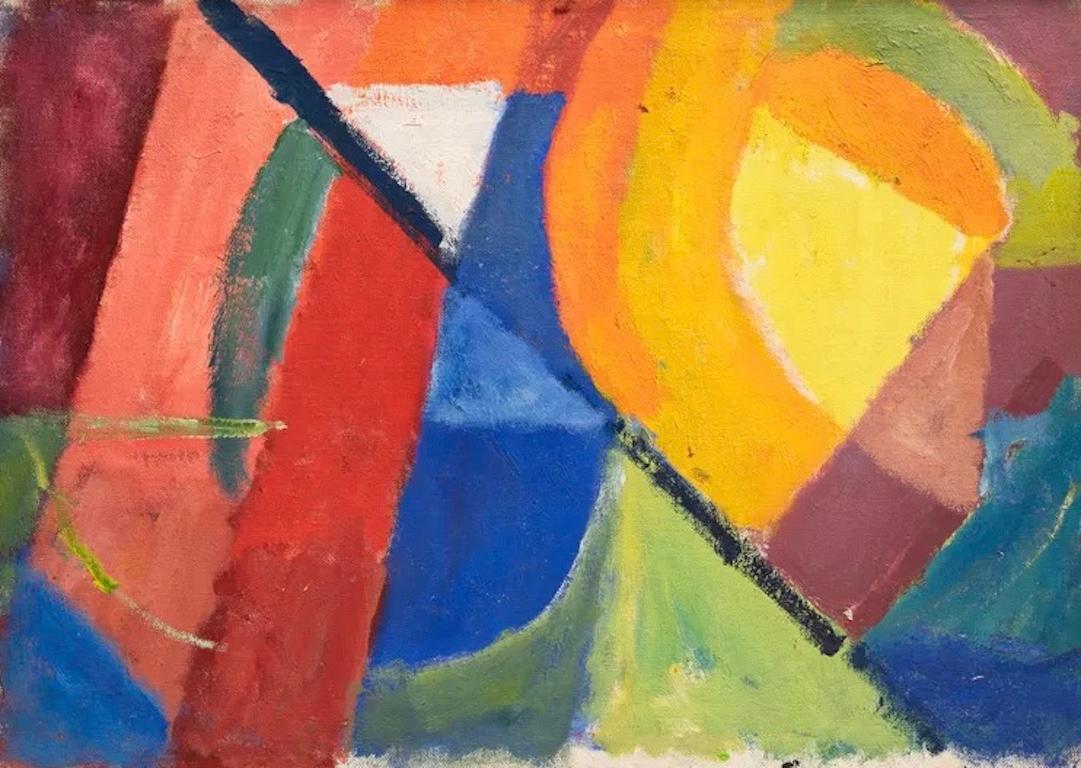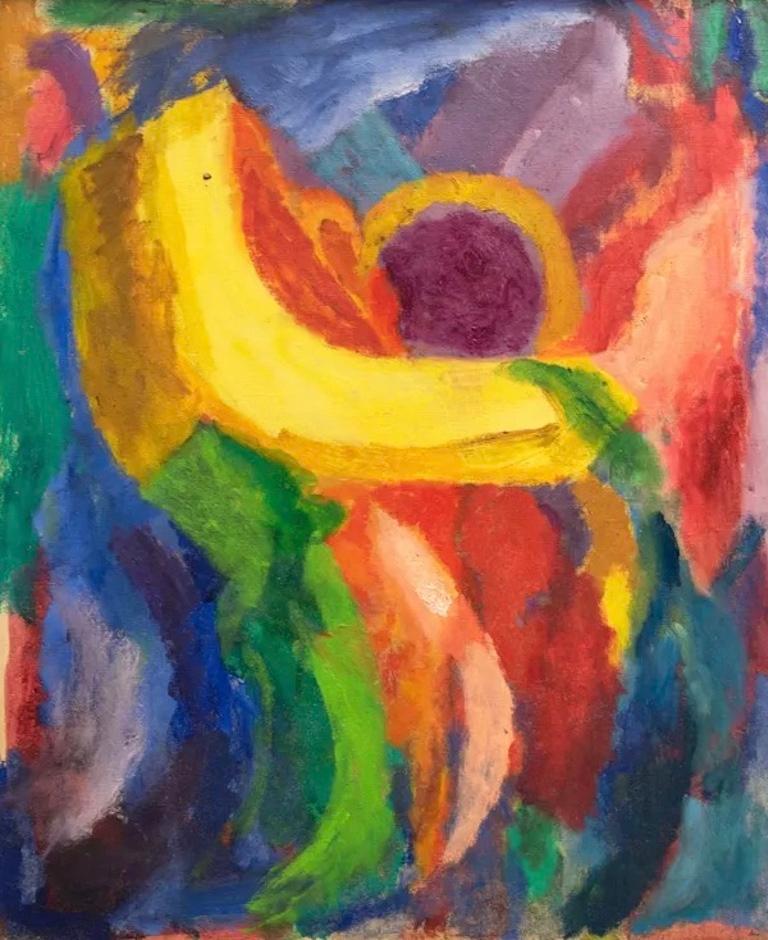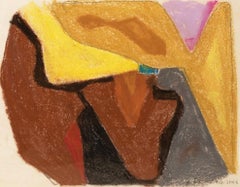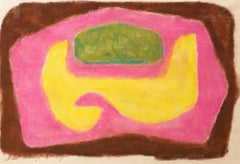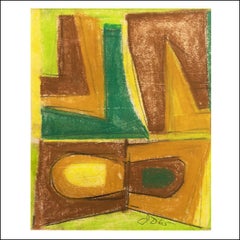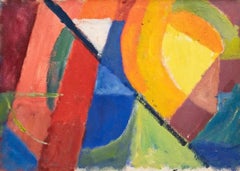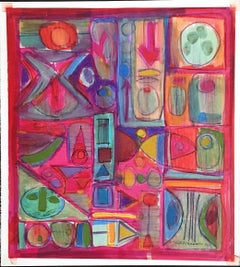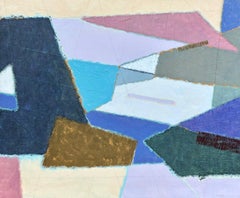Items Similar to "Untitled" Mid 20th Century American Abstract 1960s Color Field Abstraction
Want more images or videos?
Request additional images or videos from the seller
1 of 5
James Daugherty"Untitled" Mid 20th Century American Abstract 1960s Color Field Abstraction1966
1966
$8,500
£6,478.37
€7,405.19
CA$11,958.96
A$13,100.67
CHF 6,895.68
MX$156,359.98
NOK 87,902.53
SEK 80,356.16
DKK 55,315.47
About the Item
"Untitled" Mid 20th Century American Abstract 1960s Color Field Abstraction
James Daugherty (1887 – 1974)
Untitled
9 x 16 inches
Initialed lower right
Dated November 1, 1966 lower left
pastel on paper
Provenance: Estate of the Artist.
BIO
Among the early American modernists, James Daugherty was one of the first exponents of abstract color painting. Throughout his career, whether he was working in an abstract or a representational mode, Daugherty felt pure color to be the most effective means of creating powerful and evocative works of art.
Daugherty was born in Asheville, North Carolina, near the Great Smoky Mountains. He received his formal training at the Corcoran School of Art in Washington, D.C. and at the Pennsylvania Academy of the Fine Arts in Philadelphia during the early years of the last century. Although he was in Europe from 1905 until 1907, he remained unaffected by avant-garde art until the groundbreaking Armory Show of 1913.
Daugherty worked in a futurist manner until late 1914 or early 1915, when he came into contact with Arthur B. Frost, Jr., who had recently returned from Paris, where he had worked closely with Robert and Sonia Delaunay, the inventors of Orphic Cubism. Inspired by Frost's example, Daugherty began to explore the use of pure color in conjunction with abstract design. He soon developed a style consisting of highly complex arrangements of strips, segments, and circles of color. Daugherty quickly became one of the foremost proponents of color painting and in turn, influenced other young American painters, including Jay Van Everen. During these years, Daugherty exhibited his work at the Society of Independent Artists in New York and later with the Société Anonyme, Inc.
In the 1920s, Daugherty responded to the call for indigenous subject matter by adopting a more figurative style while retaining his former emphasis on vibrant color. He subsequently produced numerous easel paintings and murals, most notably his Spirit of Cinema America (1920; Loew's State Theatre, Cleveland). He continued his mural work in to the 1930s, but eventually devoted much of his time to illustrating children's books.
In 1953 Daugherty once again began to create abstract paintings. The first of these works, small images with relatively stable compositions and subdued palettes, suggest the influence of the work of Piet Mondrian. By the end to the decade, Daugherty had expanded to larger formats and had broken from the grid to create increasingly complex designs. In the years that followed, he alternated modes, often joining his old rectilinear format of vertical and horizontal with circles and frequently using a lighter, more refined painterly touch and layered, almost transparent color planes that recall the color veils of Mark Rothko's art.
By the mid-1960s Daugherty's work reached a peak of size, complexity, and color intensity. The explosive energies of these paintings put into physical form what Daugherty called the "out rushing forces of the cosmos" in an "ever expanding infinitude." Fusing the old and the contemporary, Daughterty referred both to early modernism and to the abstract illusionism developed by younger artists in the 1960s such as Frank Stella, Al Held, and Ron Davis. Daugherty continued to paint until the end of his life, never ceasing to experiment and find ways that abstraction could "restore meaning to life and announce its beauty and capacity."
Examples of Daugherty's paintings can be found in many important public collections, including the Fine Arts Museums of San Francisco; Ackland Art Museum, University of North Carolina, Chapel Hill; Amon Carter Museum, Fort Worth, Texas; Asheville Art Museum, North Carolina; The Columbus Museum, Georgia; The Detroit Institute of Arts, Michigan; Flint Institute of Arts, Michigan; Heckscher Museum, Huntington, New York; Hirshhorn Museum and Sculpture Garden, Smithsonian Institution, Washington, D.C.; Hood Museum of Art, Dartmouth College, Hanover, New Hampshire; Hoover Institution, Stanford University, California; The Marion Koogler McNay Art Museum, San Antonio, Texas; The Montclair Art Museum, New Jersey; The Museum of Modern Art, New York; New Britain Museum of American Art, Connecticut; Portland Museum of Art, Maine; Sheldon Swope Art Museum, Terre Haute, Indiana; Smithsonian American Art Museum, Washington, D.C.; Société Anonyme Collection, Yale University Art Museum, New Haven, Connecticut; The Spencer Collection, The New York Public Library, New York; Stanford University, California; Telfair Academy of Arts and Sciences, Savannah, Georgia; and Whitney Museum of American Art, New York.
About the Seller
5.0
Gold Seller
Premium sellers maintaining a 4.3+ rating and 24-hour response times
Established in 2008
1stDibs seller since 2019
197 sales on 1stDibs
Typical response time: <1 hour
- ShippingRetrieving quote...Shipping from: Pawling, NY
- Return Policy
More From This Seller
View All"Untitled" Mid 20th Century American Abstract 1960s Color Field Abstraction
Located in New York, NY
"Untitled" Mid 20th Century American Abstract 1960s Color Field Abstraction
James Daugherty (1887 – 1974)
Untitled
12 ¼ x 15 ¼ inches
Initialed and dated February 21, 1966 lower ri...
Category
1960s Abstract Abstract Drawings and Watercolors
Materials
Paper, Pastel
"Untitled" Mid 20th Century American Abstract 1960s Color Field Abstraction
Located in New York, NY
"Untitled" Mid 20th Century American Abstract 1960s Color Field Abstraction
James Daugherty (1887 – 1974)
Untitled
15 x 21 ½ inches
May 15, 1967
Pastel on paper
Signed lower left
...
Category
1960s Abstract Abstract Drawings and Watercolors
Materials
Paper, Pastel
"Untitled" Mid 20th Century American Abstract 1960s Color Field Abstraction
Located in New York, NY
"Untitled" Mid 20th Century American Abstract 1960s Color Field Abstraction
James Daugherty (1887 – 1974)
"Untitled"
10 1/2 x 8 inches
Pastel on paper
Initialed lower right and dat...
Category
1960s Abstract Abstract Drawings and Watercolors
Materials
Pastel
"Abstraction" Mid-20th Century American Abstract 1960s Color Field Modernist
Located in New York, NY
"Abstraction" Mid-20th Century American Abstract 1960s Color Field Modernist
James Daugherty (1887 – 1974)
Abstraction
14 x 18 inches
Estate stamp verso
Oil on panel
Provenance: ...
Category
1960s Abstract Abstract Paintings
Materials
Oil, Panel
"Untitled" Mid 20th Century American Abstract 1960s Color Field Abstraction
Located in New York, NY
"Untitled" Mid 20th Century American Abstract 1960s Color Field Abstraction
James Daugherty (1887 – 1974)
"Untitled"
17 x 8 inches
Pastel on paper, c. 1960s
Initialed lower right
...
Category
1960s Abstract Abstract Drawings and Watercolors
Materials
Pastel
"Abstraction" Mid-20th Century American Abstract 1960s Color Field Modernist
Located in New York, NY
"Abstraction" Mid-20th Century American Abstract 1960s Color Field Modernist
James Daugherty (1887 – 1974)
Abstraction
24 x 20 inches
Estate stamp verso
Oil on panel
Provenance: ...
Category
1960s Abstract Abstract Paintings
Materials
Canvas, Oil
You May Also Like
Vintage French Mid-Century Abstract
By D. Wargon
Located in Houston, TX
Mid-century oil pastel abstract incorporating a vast array of color and unique shapes by artist D. Wargon, circa 1950. Signed lower right.
Original artwork on paper displayed on a...
Category
1950s Abstract Drawings and Watercolors
Materials
Oil Pastel, Paper
Untitled mid century modern geometric abstraction
By William Fredericksen
Located in New York, NY
William Fredericksen
Untitled mid century modern geometric abstraction, 1958-1959
Watercolor and Gouache on Board
Hand signed and dated on the front
12 4/5 × 11 7/10 inches
Unframed
...
Category
Mid-20th Century Abstract Geometric Abstract Drawings and Watercolors
Materials
Mixed Media, Watercolor, Gouache
"Untitled" James Suzuki, Abstract Color Field Composition, Mid-Century
By James Suzuki
Located in New York, NY
James Suzuki
Untitled, circa 1960
Signed lower right "Suzuki"
Acrylic on canvas
66 1/4 x 80 inches
Provenance:
Private Collection, New Jersey
James Hiroshi Suzuki...
Category
1960s Color-Field Abstract Paintings
Materials
Canvas, Oil
1950s Mid Century Abstract Expressionist Drawing
Located in Arp, TX
From the estate of Jerry and Ruth Opper
Abstract Expressionism Drawing
c.1950s
Ink and Pastel Drawing
18" x 12" Unframed
Unsigned
*Custom framing available ...
Category
Mid-20th Century American Modern Abstract Drawings and Watercolors
Materials
Paper, Pastel, Ink
Color is Life — Mid-Century Abstract Expressionism
Located in Myrtle Beach, SC
Ernest A. Dieringer, Untitled (Color is Life), watercolor, 1959. Initialed 'ED' and dated ' '59' in red pencil at the top and bottom sheet edges—the artist's indication that the work can be viewed from either side. Signed 'Dieringer' in pencil in the bottom support board margin.
A fine abstract expressionist work, watercolor on white wove paper, with fresh, bright colors; the image extends to the sheet edges, spot glued to the original cream wove backing board, in very good condition. Archivally matted to museum standards, unframed.
Image size 9 x 10 15/16 inches; backing board size 13 1/2 x 16 3/4 inches.
Provenance: ex. Collection Alexander Raydon. The collector/dealer's well-known 'Raydon Gallery' was established in 1962 on 82nd Street and Madison Avenue, New York City.
ABOUT THE ARTIST
Ernest Dieringer studied at the Art Institute of Chicago on a National Scholastic Scholarship, beginning his career with the Chicago-based Wells Street Gallery in 1957. He showed his work with other abstract artists, including Robert Natkin and John Chamberlain. The gallery was considered a vanguard space in Chicago for exhibiting emerging abstract artists from the surrounding area. Artists associated with the gallery eventually became known as the Wells Street Group. Due to the success of the gallery, Dieringer and other group members were invited by the Manhattan-based contemporary art dealer...
Category
1950s Abstract Expressionist Abstract Drawings and Watercolors
Materials
Watercolor
Untitled Mid-Century Modern Geometric Abstraction
By Rolph Scarlett
Located in New York, NY
Rolph Scarlett
Untitled Mid-Century Modern Geometric Abstraction, ca. 1950
Gouache on paper painting
Hand signed on lower right front
This is a stunning original, signed vintage 1950...
Category
Mid-20th Century Abstract Geometric Abstract Paintings
Materials
Gouache, Mixed Media, Pencil
More Ways To Browse
Mid Century Abstract Cubism Art
Mid Century Modern Texas Art
Mark Rothko Works On Paper
1960s Abstract Painting Framed
Ron Davis
James Field
Smoky Mountains
James Daugherty
Jack Roberts Abstract Painting
John Haley On Sale
Kaji Aso
Kiel Painting
Lana Khayat
Laura Antiques
Martin Kallman
Paul Kane Painting
Paul Peters
Roger Desserprit
